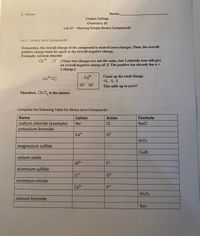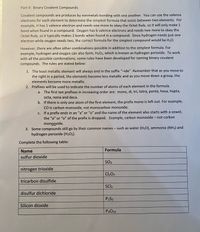
Chemistry
10th Edition
ISBN: 9781305957404
Author: Steven S. Zumdahl, Susan A. Zumdahl, Donald J. DeCoste
Publisher: Cengage Learning
expand_more
expand_more
format_list_bulleted
Question
thumb_up100%
I have already completed the lab as a study guide but I want to compare my data!

Transcribed Image Text:D. Gibson
Name:
Chabot College
Chemistry 10
Lab #7 – Naming Simple Binary Compounds
Part I: Binary lonic Compounds
Remember, the overall charge of the compound is neutral (zero charge). Thus, the overall
positive charge must be equal to the overall negative charge.
Example: calcium chloride
CI (These two charges are not the same, but 2 chloride ions will give
an overall negative charge of -2. The positive ion already has a +
2 charge.)
Ca
2+
Count
up
the total charge.
+2, -1, -1
CT CI
This adds up to zero!!
Therefore, CaCl, is the answer.
Complete the following Table for Binary lonic Compounds:
Name
Cation
Anion
Formula
sodium chloride (example)
Na*
CI
NaCl
potassium bromide
Ca2+
02-
SrCl2
magnesium sulfide
Cs3N
cesium oxide
Al3+
F1-
aluminum sulfide
:1+
02-
strontium nitride
Ca2+
p3-
Al2O3
calcium bromide
Bal2

Transcribed Image Text:Part II: Binary Covalent Compounds
Covalent compounds are produces by nonmetals bonding with one another. You can use the valence
electrons for each element to determine the simplest formula that exists between two elements. For
example, H has 1 valence electron and needs one more to obey the Octet Rule, so it will only make 1
bond when found in a compound. Oxygen has 6 valence electrons and needs two more to obey the
Octet Rule, so it typically makes 2 bonds when found in a compound. Since hydrogen needs just one
electron while oxygen needs two, the correct formula for the simplest compound would be H20.
However, there are often other combinations possible in addition to the simplest formula. For
example, hydrogen and oxygen can also form, H2O2, which is known as hydrogen peroxide. To work
with all the possible combinations, some rules have been developed for naming binary covalent
compounds. The rules are stated below:
1. The least metallic element will always end in the suffix "-ide". Remember that as you move to
the right in a period, the elements become less metallic and as you move down a group, the
elements become more metallic.
2. Prefixes will be used to indicate the number of atoms of each element in the formula.
a. The first ten prefixes in increasing order are: mono, di, tri, tetra, penta, hexa, hepta,
octa, nona and deca.
b. If there is only one atom of the first element, the prefix mono is left out. For example,
CO is carbon monoxide, not monocarbon monoxide.
C. If a prefix ends in an "a" or "o" and the name of the element also starts with a vowel,
the "a" or "o" of the prefix is dropped. Example, carbon monoxide - not carbon
monooxide.
3. Some compounds still go by their common names – such as water (H2O), ammonia (NH3) and
hydrogen peroxide (H2O2).
Complete the following table:
Name
Formula
sulfur dioxide
SO3
nitrogen trioxide
Cl207
tricarbon disulfide
SCI2
disulfur dichloride
P2S5
Silicon dioxide
P4010
Expert Solution
This question has been solved!
Explore an expertly crafted, step-by-step solution for a thorough understanding of key concepts.
Step by stepSolved in 2 steps

Knowledge Booster
Learn more about
Need a deep-dive on the concept behind this application? Look no further. Learn more about this topic, chemistry and related others by exploring similar questions and additional content below.Similar questions
- 8.0 cm 5.8 cm 3.9 cm 1.5 cm A B C D Figure 2. Developed TLC plate of commercial analgesic and standards Use the data presented in Figure 2 as basis for your answer. The TLC plate used is 5 cm by 10 cm. Note that dot A is for the commercial analgesic, dot B is for the aspirin standard, dot C is for the acetaminophen standard, and dot D is for the caffeine standard. What component/s islare present in the commercial analgesic as confirmed on the developed chromatograph?arrow_forwardHow do I calculate the volume I recorded with a 10 mL pipet?arrow_forwardName: Part I: Calibration of the Plastic Pipette Number of Drops Total Mass (g) Mass of 10 Drops (g) Volume of 10 Drops (mL) 23.3124 10 23.8216 20 24.2999 30 24.8245 1. Temperature of deionized water (°C) 24.7 2. Density of water at this temperature from (g/mL) Density calculator https://antoine.frostburg.edu/chem/senese/javascript/water-density.html 3. Average volume of 10 drops (mL) show calculation: Part II: Determination of Standard Solutions mL of 0.200M CuSO4'5 H20 added M CuSO4 diluted Absorbance Tube # mL H20 added 0.200 1.346 about 3 0.945 3 4.00 1.00 0.715 4 3.00 2.00 0.469 2.00 3.00 0.281 6. 1.00 4.00 show calculation for Tube #3 diluted concentration:arrow_forward
- Calculating BMI with English Units Khloe is 5 feet, 9 inches (5’9”) and 170 lbs. Calculate her BMI. (Round to the nearest 0.1.) what is her weight statusarrow_forwardI asked this before and the person said there was no data....i submitted the data in one picture and question in the second image! this is literally all of the information i have! that's why i am asking for help!!!arrow_forwardI am not asking for help in writing this report. Could you solve the calculation parts for the steps on the last page? like 13, 14, 15, 17, 18, and 19. This experiment is based on this video: https://www.youtube.com/watch?v=SVvGtcFhdlsarrow_forward
- Using the following mass standard data, calculate the Rx value. mass of mass of area of area of isopentyl acetate (g) isopentyl alcohol (g) isopentyl acetate peak isopentyl alcohol peak 80.0 1.10 1.28 189 Please report your answer to 3 decimal places. (No units required)arrow_forwardE ! G Google Docs: Online Document Editor | Google Workspace Hiranrat_Analysis_CHM235LL DO File Edit View Insert Format Tools Extensions Help A P 100% F1 C Pure A: Pure B: Pure C: Compound 2 F2 Normal text A 146 1 BO с O junk O Crude Fractions. The following table shows a sequence of TLC "lanes" that correspond to fractions collected from a column. After completing the column, a student wants to condense containers while maintaining high purity for each of the components, then what fractions, if any, can be combined to provide # 3 Y 1 2 80 F3 O Times New... Y - 11 + 213 Oo 3 2 0 0 0 0 0 0 0 $ 4 Last edit was 2 minutes ago B IU A UA 45 S Fractions from column 000 F4 6 docs.google.com Hiranrat Analysis_CHM235LL - Google Docs % 5 F5 6 O GOD O O 2 = 2 MacBook Air F6 & 7 6 E 7 F7 Solvent Front Starting Line T 8 DII IE = E 8 9 y DD C F9 pearrow_forwardStandard deviation- 0.0371 mL, 0.0392 mL, 0.0392 mL, 0.03887 mL, 0.0398 mL Mean- 0.194 mLarrow_forward
arrow_back_ios
arrow_forward_ios
Recommended textbooks for you
 ChemistryChemistryISBN:9781305957404Author:Steven S. Zumdahl, Susan A. Zumdahl, Donald J. DeCostePublisher:Cengage Learning
ChemistryChemistryISBN:9781305957404Author:Steven S. Zumdahl, Susan A. Zumdahl, Donald J. DeCostePublisher:Cengage Learning ChemistryChemistryISBN:9781259911156Author:Raymond Chang Dr., Jason Overby ProfessorPublisher:McGraw-Hill Education
ChemistryChemistryISBN:9781259911156Author:Raymond Chang Dr., Jason Overby ProfessorPublisher:McGraw-Hill Education Principles of Instrumental AnalysisChemistryISBN:9781305577213Author:Douglas A. Skoog, F. James Holler, Stanley R. CrouchPublisher:Cengage Learning
Principles of Instrumental AnalysisChemistryISBN:9781305577213Author:Douglas A. Skoog, F. James Holler, Stanley R. CrouchPublisher:Cengage Learning Organic ChemistryChemistryISBN:9780078021558Author:Janice Gorzynski Smith Dr.Publisher:McGraw-Hill Education
Organic ChemistryChemistryISBN:9780078021558Author:Janice Gorzynski Smith Dr.Publisher:McGraw-Hill Education Chemistry: Principles and ReactionsChemistryISBN:9781305079373Author:William L. Masterton, Cecile N. HurleyPublisher:Cengage Learning
Chemistry: Principles and ReactionsChemistryISBN:9781305079373Author:William L. Masterton, Cecile N. HurleyPublisher:Cengage Learning Elementary Principles of Chemical Processes, Bind...ChemistryISBN:9781118431221Author:Richard M. Felder, Ronald W. Rousseau, Lisa G. BullardPublisher:WILEY
Elementary Principles of Chemical Processes, Bind...ChemistryISBN:9781118431221Author:Richard M. Felder, Ronald W. Rousseau, Lisa G. BullardPublisher:WILEY

Chemistry
Chemistry
ISBN:9781305957404
Author:Steven S. Zumdahl, Susan A. Zumdahl, Donald J. DeCoste
Publisher:Cengage Learning

Chemistry
Chemistry
ISBN:9781259911156
Author:Raymond Chang Dr., Jason Overby Professor
Publisher:McGraw-Hill Education

Principles of Instrumental Analysis
Chemistry
ISBN:9781305577213
Author:Douglas A. Skoog, F. James Holler, Stanley R. Crouch
Publisher:Cengage Learning

Organic Chemistry
Chemistry
ISBN:9780078021558
Author:Janice Gorzynski Smith Dr.
Publisher:McGraw-Hill Education

Chemistry: Principles and Reactions
Chemistry
ISBN:9781305079373
Author:William L. Masterton, Cecile N. Hurley
Publisher:Cengage Learning

Elementary Principles of Chemical Processes, Bind...
Chemistry
ISBN:9781118431221
Author:Richard M. Felder, Ronald W. Rousseau, Lisa G. Bullard
Publisher:WILEY